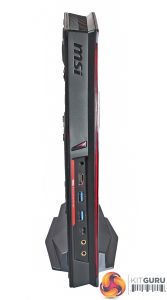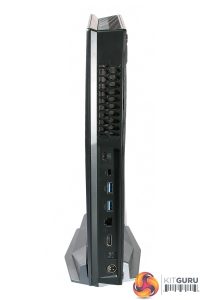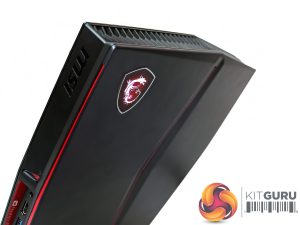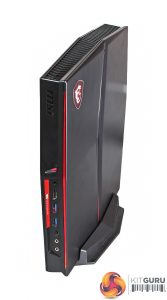The mobile variant of the GTX 1070 has been chosen to provide desktop-level power – a sensible choice for a machine that’s this small, and not a thermal concern thanks to Nvidia’s excellent Pascal architecture.
The mobile core has 2,048 stream processors rather than the 1,920 included with the desktop card, and it retains the 8GB of memory.
MSI has also given the chip a boost to get a little closer to true desktop performance. The original clock speed of 1,443MHz has been overclocked to 1,643MHz, which means boost speeds will rise beyond 1,845MHz. It’s also possible to add a little extra juice using MSI’s Dragon Center tool, which also has system monitoring modules and lighting controls.
It’s the same GPU that’s included in the Trident 3 – another small gaming system from MSI – and the Overclockers UK Titan Katana, which had the same GPU with a slightly lesser overclock.
The PC Specialist Magma LX goes a step further, despite its lower price – it deploys a GTX 1070 Ti, which has 2,432 stream processors and a 1,607MHz stock speed. And, at the top of the stack, is the expensive Corsair One Elite, which has a GTX 1080 Ti.
The graphics card is underpinned by a Core i7-8700. It’s one of Intel’s newest processors, which means it’s got the full might of the Coffee Lake architecture and two more cores when compared to last year’s chips – but it doesn’t have the K suffix, which means there’s no scope for overclocking.
That’s hardly a concern in a tiny machine like this, but it does mean that full-size machines may offer more speed: the Overclockers UK machine takes a Ryzen 7 1700 and tweaks it to 3.8GHz.
The absence of K-branding also means that conventional clock speeds are cut back. The i7-8700’s stock speed of 3.2GHz is 200MHz behind the i7-8700K. Its top boost speed of 4.6GHz is 100MHz behind the full-fat chip.
The MSI’s laptop origins mean cutbacks elsewhere, too. We have no problems with the memory capacity of 16GB, but its 2,400MHz speed is a little behind – the other small MSI machine sticks with that speed, but the PC Specialist rig ramps it up to 3,000MHz.
There’s not much special about the storage, either. The 256GB SSD and 1TB hard disk have fine capacities, but the older Samsung PM871a drive and 2.5in Hitachi TravelStar disk won’t break any speed records.
Elsewhere, you’ll find Gigabit Ethernet and Killer-branded 802.11ac wireless. That’s fine, but you do miss out on the various motherboard extras that are included in full-size desktop systems, especially at this price.
The Overclockers and PC Specialist machines are both full-size desktops, for instance, and so both will offer a huge amount of extra versatility and upgrade room – and for a lot less cash than the MSI.
And then, of course, it’s also possible to save cash by building your own. A home-built ATX machine will be hundreds of pounds cheaper, of course, but a mini-ITX rig will also be more affordable. We replicated the MSI’s specification online, and the system could be built for between £1,600 and £1,700, depending on the components you choose.
And then, of course, there are laptops. It’s easy to find gaming notebooks with GTX 1070 graphics and Core i7 processors for less than £1,885, and those machines obviously come with their own screens, keyboards and trackpads. They don’t have Coffee Lake yet, but that won’t make much difference to gaming.
Be sure to check out our sponsors store EKWB here
 KitGuru KitGuru.net – Tech News | Hardware News | Hardware Reviews | IOS | Mobile | Gaming | Graphics Cards
KitGuru KitGuru.net – Tech News | Hardware News | Hardware Reviews | IOS | Mobile | Gaming | Graphics Cards






